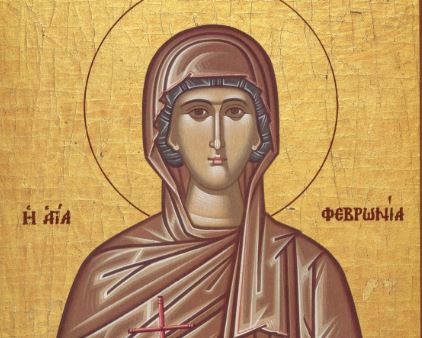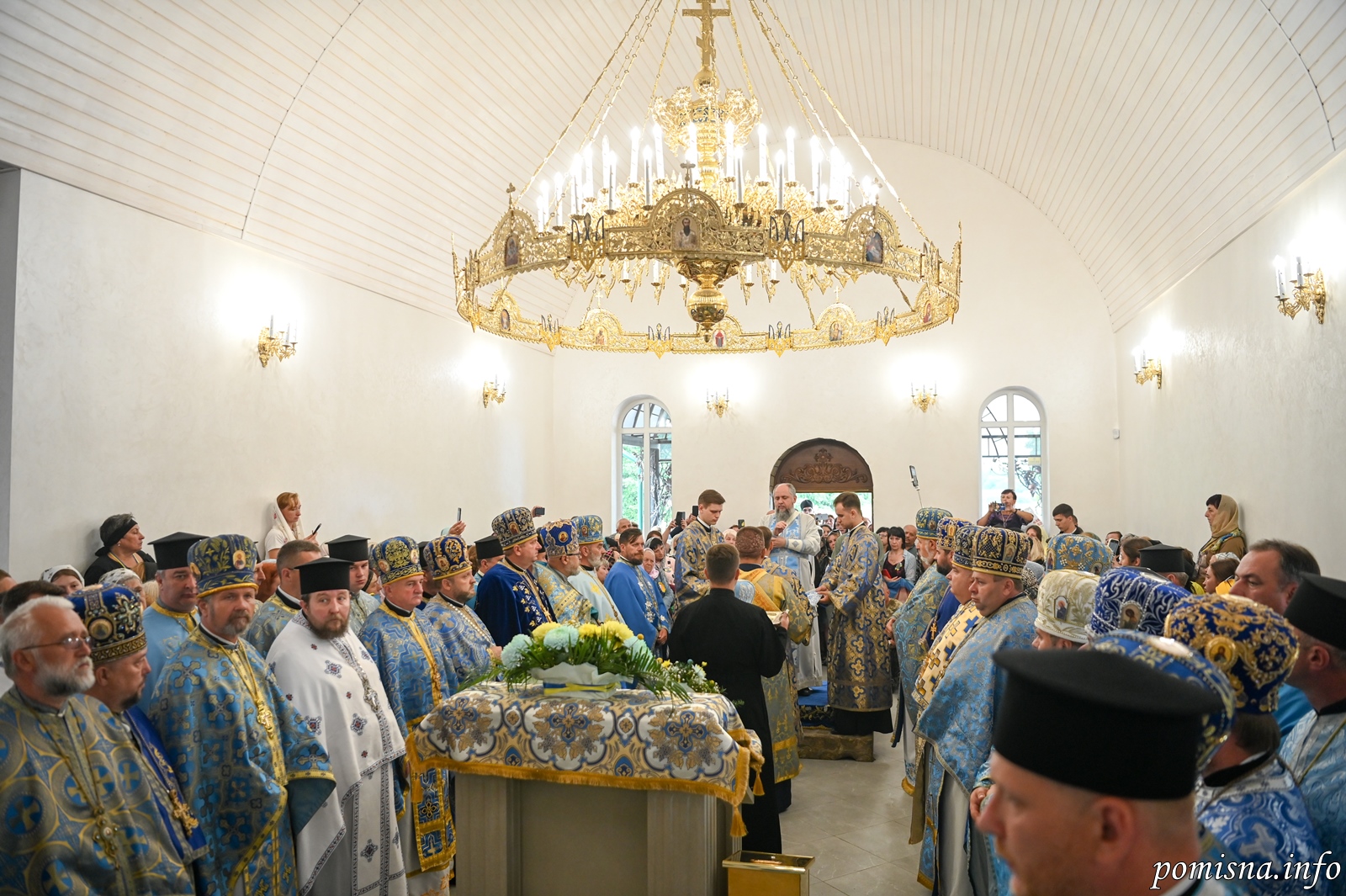Saint Fevronia the Righteous Martyr (25 June)


The Virgin Martyr Febronia suffered during the reign of Diocletian (284-305). She was raised at a monastery in the city of Sivapolis (Assyria). The head of the women’s monastery was the abbess Bryaίnē, the aunt of Saint Febronia. Being concerned about her niece’s salvation, she assigned her a stricter form of life than the other nuns. According to their monastic rule, on Fridays the sisters put aside their other duties and spent the whole day in prayer and the reading of Holy Scripture. The abbess usually assigned the reading to Saint Febronia.
News of her pious life spread throughout the city. The illustrious young widow Hieria, a pagan, began to visit her, and under the influence of her guidance and prayer she accepted holy Baptism, bringing her parents and kinsfolk to the Christian Faith.
Diocletian sent a detachment of soldiers to Assyria under the command of Lysimachus, Selinus and Primus for the destruction of Christians. Selenos, the uncle of Lysimachus, was noted for his fierce attitude against Christians, but Lysimachus was of a different frame of mind from him, since his mother had sought to inspire love for the Christian faith in her son, and she had died a Christian. Lysimachus had discussed with his kinsman Primus how it would be possible to deliver Christians from the hands of the torturer. When the detachment of soldiers approached the convent, its inhabitants hid. There remained only the abbess Bryaίnē, her helper Thomais and Saint Febronia, who was seriously ill at the time.
It grieved the abbess terribly that her niece might fall into the hands of the torturers, who might defile her. She prayed fervently that the Lord would preserve her and strengthen her in the confession of Christ the Savior. Selinus gave orders to bring him all the nuns of the convent. Primus with the detachment of soldiers found no one, except the two old women and Saint Febronia. He regretted that they had not hidden, and he suggested to the nuns that they flee. But the nuns decided not to leave the place of their labors and they entrusted themselves to the will of the Lord.
Primus told Lysimachus about the particular beauty of Saint Febronia and advised him to take her for himself. Lysimachus said that he would not seduce a virgin dedicated to God, and he asked Primus to hide the other nuns somewhere so that they would not fall into the hands of Selinus. One of the soldiers overheard the conversation and told Selinus. They led Saint Febronia off to the military commander with her hands bound and a chain around her neck. Selinus urged her to deny Christ, promising her honors, rewards, and marriage with Lysimachus. The holy virgin firmly and fearlessly answered that she had an Immortal Bridegroom, and she would not exchange Him for any mortal man. Selinus subjected her to fierce torture. The saint prayed, “My Savior, do not abandon me in this terrible hour!”
They beat the martyr for a long time, and blood flowed from her wounds. In order to intensify the suffering of Saint Febronia, they tied her to a tree and set a fire under it. The tortures were so inhuman, that the people began to demand an end to the torture, since there was no confession of guilt by the girl. Selinus continued to mock and jeer at the martyr, but Saint Febronia became silent. Because of weakness she was unable to utter a word. In a rage Selinus gave orders to tear out her tongue, smash her teeth, and finally, to cut off both hands and feet. The people were unable to bear such a horrid spectacle and they left the scene of the torture, cursing Diocletian and his gods.
Among the crowd was the nun Thomais, who afterwards recorded Saint Febronia’s martyrdom in detail, and also her student Hieria. She came forth out of the crowd and in the hearing of all reproached Selinus for his boundless cruelty. He gave orders to arrest her, but learning that Hieria was of illustrious standing whom he could not readily subject to torture, he said, “By your speech you have brought on Febronia even greater torment.” Finally, they beheaded the holy Martyr Febronia.
Departing the place of execution, Lysimachus wept and withdrew to his quarters. Selinus made ready to eat, but he was not able to take food, and went off to the quiet of his own chambers. Suddenly, he became like one deranged. Looking up to the heavens, he raved and bellowed like a bull, then fell down and struck his head on a marble column and died. When Lysimachus learned of this, he said, “ Great is the God of the Christians, Who has avenged Febronia’s blood, so unrighteously shed!” He prepared a coffin, placed the martyr’s body in it, and took it to the convent.
Abbess Bryaίnē fell senseless, seeing the mutilated remains of Saint Febronia. Later, she recovered her senses and gave orders to open the convent gates so that all would be able to come and venerate the holy martyr and glorify God Who had given her such endurance in suffering for Christ. Lysimachus and Primus renounced their idol worship and accepted both Baptism and monasticism. Hieria gave her wealth to the convent and petitioned Abbess Bryaίnē to accept her at the convent in place of Saint Febronia.
Every year, on the day of the martyric death of Saint Febronia, a solemn feast was celebrated at the convent. During the time of the all-night Vigil the nuns always saw Saint Febronia, at her usual place in church. From the relics of Saint Febronia occurred numerous miracles and healings. The Life of Saint Febronia was recorded by the nun Thomais, an eyewitness to her deeds.
In the year 363 the relics of Saint Febronia were transferred to Constantinople.
Soon after the death of Saint Febronia, Saint James the Bishop of Nisibis (January 13) built a church and transferred into it a portion of the of the holy martyr’s relics.
This Martyr practiced the ascetic discipline in Nisibis of Mesopotamia; she was of such great beauty that the report of her came to the persecutor Selenus, and every attempt was made to make her deny Christ. After many horrible tortures, she was cruelly dismembered by the executioners, then beheaded, in the year 310 (or, according to some, in 302, during the reign of Diocletian).
Febronia was the daughter of Prosphorus, a senator from Rome. In order to avoid marriage with a mortal man, Febronia betrothed herself to Christ and was tonsured a nun in the East, in the land of Assyria, in a convent where her aunt Bryaena was abbess. Lysimachus, the son of a nobleman, desired to wed Febronia, but since Emperor Diocletian suspected him of being a secret Christian, he sent Lysimachus to the East with his uncle Silenus to apprehend and kill Christians.
Silenus was as cruel as a beast, and he exterminated Christians everywhere without mercy. Lysimachus, on the contrary, spared the Christians wherever he could and hid them from his beastly uncle. Having made Palmyra devoid of Christians, Silenus came to the town of Nisibis, close to which was a convent with fifty ascetics, among whom was Febronia. Even though she was only twenty years old, Febronia was respected both in the convent and in the town because of her great meekness, wisdom and abstinence. In this convent they adhered to the rule of the former abbess, Blessed Platonida, that every Friday be spent only in prayer and the reading of sacred books, without any other type of work.
Bryaena had appointed Febronia to read the sacred books to the sisters while she was hidden behind a curtain, so that no one would be distracted and captivated by the beauty of her face. Hearing about Febronia, Silenus ordered that Febronia be brought to him. But, when the holy virgin refused to deny Christ or to enter into marriage with a mortal man, Silenus ordered them to whip her, then knock out her teeth, then cut off her hands and breasts and legs, and finally to slay her with a sword. But a horrible punishment from God befell the torturer that same day: a demon entered into him and he was overcome by a deadly terror. In this fear he struck his head against a marble pillar and fell dead. Lysimachus ordered that Febronia’s body be gathered and brought to the convent, where it was honorably buried, and he and many other soldiers were baptized. From the relics of St. Febronia there occurred many healings, and she appeared on the day of her feast and stood in her usual place among the sisters, and all the sisters looked upon her with fear and rejoicing. St. Febronia suffered honorably and took up her habitation in eternal blessedness in the year 310 A.D., and in the year 363 A.D. her relics were translated to Constantinople.
Apolytikion of Martyr Febronia
Fourth Tone
O Lord Jesus, unto Thee Thy lamb doth cry with a great voice: O my Bridegroom, Thee I love; and seeking Thee, I now contest, and with Thy baptism am crucified and buried. I suffer for Thy sake, that I may reign with Thee; for Thy sake I die, that I may live in Thee: accept me offered out of longing to Thee as a spotless sacrifice. Lord, save our souls through her intercessions, since Thou art great in mercy.
Kontakion of Martyr Febronia
Third Tone
In ascetic discipline, thou wast made fair as a virgin; then, O famed Febronia, thou shonest forth as a martyr; with thy lamp in hand, thou rannest unto thy Bridegroom, having watched through the night of martyric sufferings. And since thou art crowned in glory, thou intercedest for them that praise thee with faith.
Source: oca.org / goarch.org / westserbdio.org





